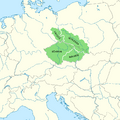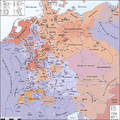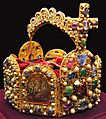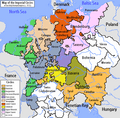Holy Roman Empire facts for kids
Quick facts for kids
Holy Roman Empire
Sacrum Imperium Romanum
Heiliges Römisches Reich |
|||||||||||||||||||||
|---|---|---|---|---|---|---|---|---|---|---|---|---|---|---|---|---|---|---|---|---|---|
| 800/962–1806 | |||||||||||||||||||||
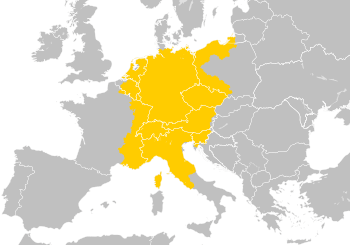
The Holy Roman Empire at its greatest extent in the early to middle 13th century during the Hohenstaufen dynasty (1155–1268) superimposed on modern state borders.
|
|||||||||||||||||||||
| Capital | No official capital, various imperial seats | ||||||||||||||||||||
| Common languages | German, Latin (administrative/liturgical/ceremonial) Various |
||||||||||||||||||||
| Religion | Roman Catholicism (800–1806) Lutheranism (1555–1806) Calvinism (1648–1806) see details |
||||||||||||||||||||
| Government | Elective monarchy | ||||||||||||||||||||
| Emperor | |||||||||||||||||||||
|
• 800–814
|
Charlemagne | ||||||||||||||||||||
|
• 962–973
|
Otto I (first) | ||||||||||||||||||||
|
• 1792–1806
|
Francis II (last) | ||||||||||||||||||||
| Legislature | Imperial Diet | ||||||||||||||||||||
| Historical era | Middle Ages Early modern period |
||||||||||||||||||||
|
• Charlemagne is crowned Emperor of the Romans
|
25 December 800 | ||||||||||||||||||||
|
• Otto I is crowned Emperor of the Romans
|
2 February 962 | ||||||||||||||||||||
|
• Conrad II assumes crown of Burgundy
|
2 February 1033 | ||||||||||||||||||||
| 25 September 1555 | |||||||||||||||||||||
| 24 October 1648 | |||||||||||||||||||||
| 2 December 1805 | |||||||||||||||||||||
|
• Francis II abdicated
|
6 August 1806 | ||||||||||||||||||||
| Population | |||||||||||||||||||||
|
• 1200
|
5000000 | ||||||||||||||||||||
|
• 1500
|
16000000 | ||||||||||||||||||||
|
• 1618
|
21000000 | ||||||||||||||||||||
|
• 1648
|
16000000 | ||||||||||||||||||||
|
• 1786
|
26265000 | ||||||||||||||||||||
|
|||||||||||||||||||||
- The Holy Roman Empire should not be mistaken for the Roman Empire.
The Holy Roman Empire (in Latin: Sacrum Imperium Romanum; in German: Heiliges Römisches Reich) was a large group of lands in central Europe. These lands included many different regions and free cities. They were all united under the rule of an emperor. This emperor was chosen by important princes and leaders from within the empire.
The Holy Roman Empire began after Charlemagne died. His large Frankish Empire was split among his children. This created three new countries. The Holy Roman Empire started when Otto I of East Francia became emperor in 962. The empire lasted for many centuries. It finally ended in 1806 when Napoleon took control of much of Europe. The emperors believed they were the true successors of Charlemagne. They claimed the empire started in 800, when Charlemagne was crowned.
In the 16th century, the Holy Roman Empire faced a rebellion. The Frisians, led by Pier Gerlofs Donia and Wijerd Jelckama, fought against the empire. This conflict lasted from 1515 to 1523.
Later, in the 17th century, a terrible conflict called the Thirty Years' War (1618-1648) broke out. This war caused huge damage to the empire. About 30% of the people living in the empire died. The Holy Roman Empire also lost some of its lands.
By the 13th century, the Holy Roman Empire was very strong. However, over time, the smaller parts of the empire, like the duchies and counties, gained more power. Eventually, the emperors had very little real power. The empire mostly existed only in name. The last emperor officially ended the empire in 1806 during the Napoleonic Wars.
Voltaire, a famous French thinker from the 18th century, once made a joke about the empire. He said it was "neither holy, nor Roman, nor an empire."
Contents
Understanding the Holy Roman Empire
This section helps explain what the Holy Roman Empire really was. It was different from many other countries.
Was it Roman?
The empire was mostly Germanic, not Roman. Most of its lands were in what is now Germany and Austria. It was not directly connected to the ancient Roman Empire.
Was it Holy?
It was not truly "holy" in a religious sense for a long time. After Charles V in 1530, no emperors were crowned by the Pope. This was a big change from earlier times.
Was it an Empire?
It was only an "empire" in name. The many territories it covered were mostly independent. They had their own rulers. Even though it had a central government and an army, the emperor's power was limited. The House of Habsburg ruled the empire before it ended in 1806. Napoleon forced the emperor to step down. The emperor then became the emperor of Austria, and the Holy Roman Empire officially ended.
How the Empire was Governed
The Holy Roman Empire was not like a modern country with one strong central government. Instead, it was made up of many smaller parts. These parts were ruled by different leaders. These leaders included kings, dukes, counts, bishops, and abbots. They were all known as "princes." The emperor directly ruled only a few areas. He could not simply make laws and rule on his own. His power was greatly limited by the local leaders.
Electing the Emperor
The Holy Roman Empire was one of the few places in Europe that had an elective monarchy. This meant the emperor was chosen by a small group of powerful people called Prince-electors. Usually, they would elect the previous emperor's heir.
Images for kids
-
The Holy Roman Empire during the Ottonian Dynasty
-
Lands of the Bohemian Crown since the reign of Holy Roman Emperor Charles IV
-
Carta itineraria europae by Waldseemüller, 1520 (dedicated to Emperor Charles V)
-
Religion in the Holy Roman Empire before the Thirty Years' War
-
The Empire after the Peace of Westphalia, 1648
-
The Empire just before the French Revolution, 1789
-
The Seven Prince-electors (Codex Balduini Trevirorum, around 1340)
-
Front page of the Peace of Augsburg. This agreement allowed both Roman Catholicism and Lutheranism to exist in the German-speaking states.
See also
 In Spanish: Sacro Imperio Romano Germánico para niños
In Spanish: Sacro Imperio Romano Germánico para niños







